
Special Talk: Introduction to Meteorology

How What Happens in the Atmosphere Can Impact Human Activities
The atmospheric phenomena that takes place high above us can affect the climate conditions we experience, which in turn can greatly impact our emotions. Two specialists from different fields have come together to explore this topic. One is SHINKAI Makoto, a Japanese animation film director particularly known for his latest creation, Weathering With You. A romantic fantasy set in a Tokyo dealing with intensifying climatic anomalies, the film's weather-themed story represents a universal topic relating to everyday lives. The other expert is OKI Riko, a researcher specializing in the science of clouds and rain. She is Deputy Director at JAXA Earth Observation Research Center (EORC).
Colorful views of Earth invisible to the human eye
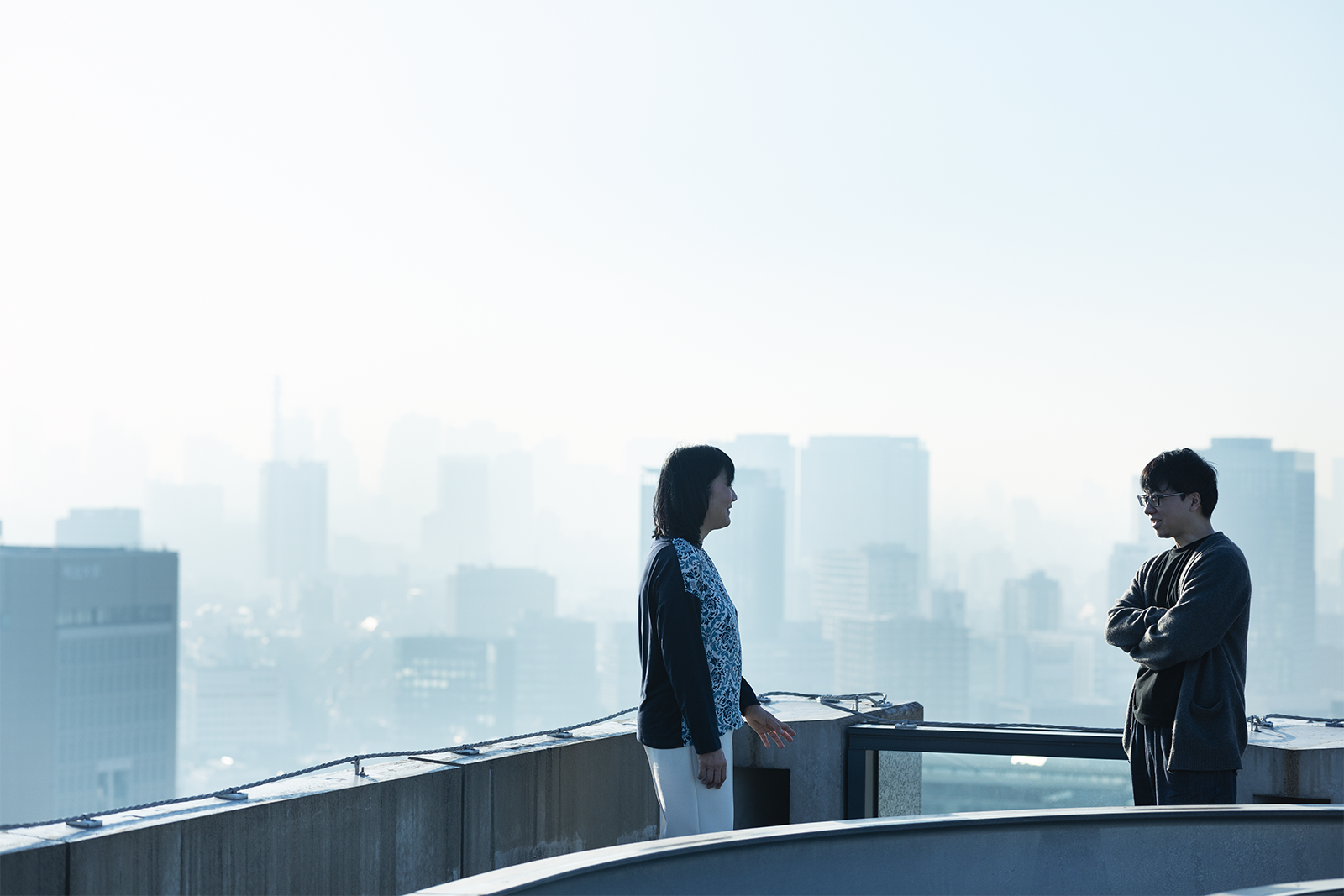
SHINKAI
I've really been looking forward to meeting you today and learning from your expertise. To be honest, I also hope to get some inspiration for my future work. Your specialty is Earth observation. Could you tell me a little bit about JAXA's newest Earth observation satellite in operation?
OKI
The latest satellite I'm involved with is "SHIKISAI," whose official name is the Global Change Observation Mission-Climate (GCOM-C). Normally, the human eye can only perceive wavelengths within the visible light spectrum, which is not enough to give the whole picture of global climate conditions. The optical sensors installed on "SHIKISAI" can perceive wavelengths outside that range, such as UV and infrared light. This is crucial in allowing it to capture colorful images of our planet invisible to the naked eye. Specifically, the satellite conducts surface and atmospheric monitoring of vegetation, ice, and cloud distributions; land and water surface temperatures; and aerosol levels in the air. This is one example an image captured by "SHIKISAI." It shows the distribution of vegetation across Japan in winter, and the only way to detect this is by tracking near-infrared wavelengths that can't be seen by human eyes.

SHINKAI
Wow! It's beautiful! What is the sensor resolution of "SHIKISAI"?
OKI
The resolution range is 250m to 1km per pixel from 800km above ground level.
SHINKAI
250m is impressive. Are images enabled by "SHIKISAI" publicly available?
OKI
Yes, they are, including for your use.
SHINKAI
Thank you. Are these images of the raw observation data, or have they undergone some kind of conversion process?
OKI
The raw observation data is processed using physical and engineering techniques to deliver images in color spectra compatible with human visual interpretation.
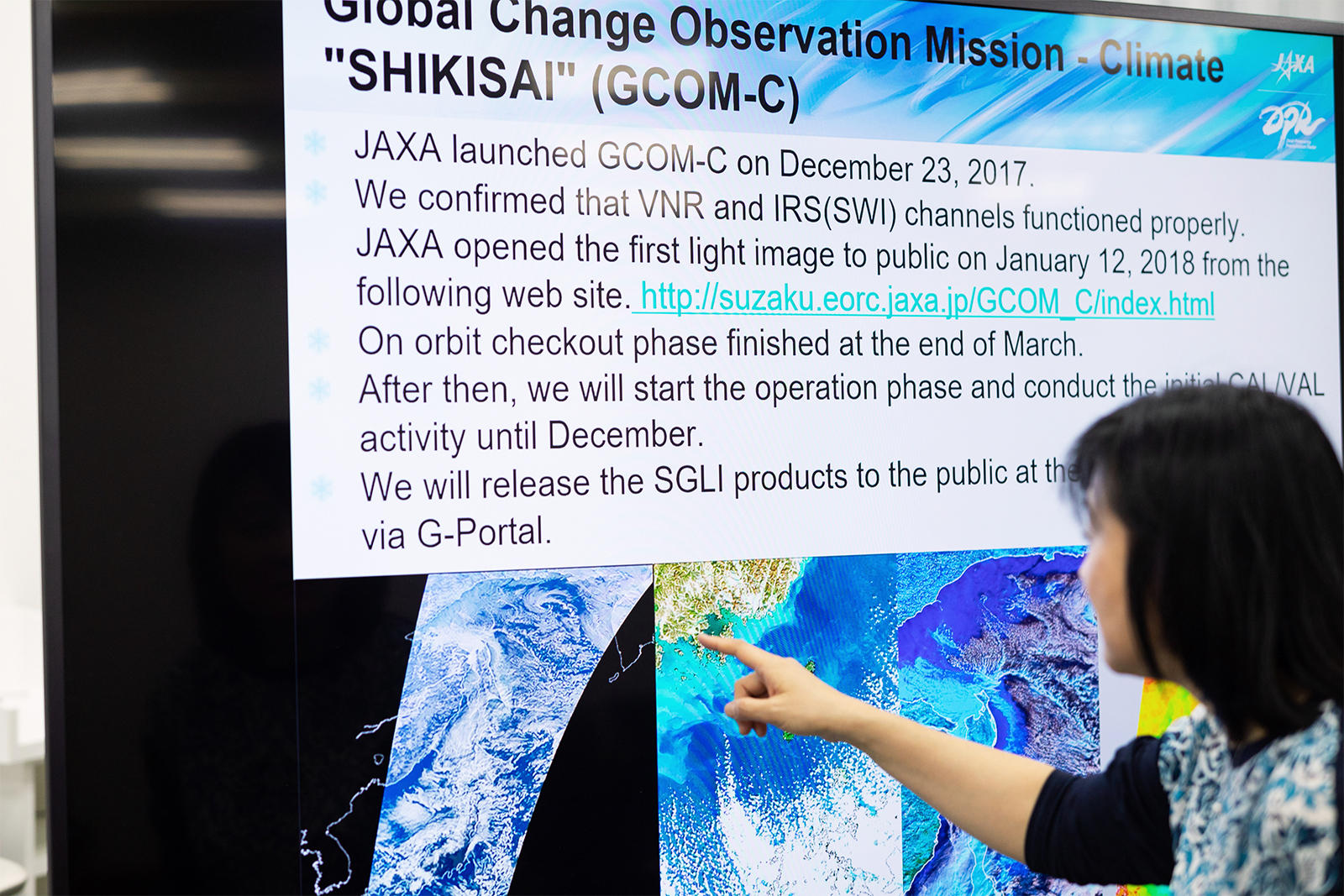
SHINKAI
I see. I've always been intrigued by the idea of how the world must look when viewed outside the visible spectrum. Bats, for example, can perceive infrared light that humans can't. I wish I could see the world the way bats do, to experience it in ways that elude human sensory biology. I've been curious about that for a long time.
OKI
Our sight is restricted by our inherent resolution capability.
SHINKAI
I agree. I have another long-held desire in that regard. I wish I could see, or know, what happens in a cloud. In fact, that's one reason why I created Weathering With You. My interest in clouds was particularly inspired by the depiction of a cloud system in Laputa: Castle in the Sky, an animated film directed by MIYAZAKI Hayao.
OKI
Are you talking about "the Dragon's Nest"?
SHINKAI
Exactly, "the Dragon's Nest." In the story, it is the name of a gigantic low pressure system. At the center of the spiral-shaped cloud system, the wind blows in the opposite direction from the area around it, and it's full of violent thunder. The small kite Princess Sheeta and her friend are on gets separated from the Tiger Moth airship and drawn into the storm-swept cloud, where they find Laputa. I saw the movie as a junior high school student, and I'll never forget that awe-inspiring scene. I was wowed at the way they depicted the atmospheric phenomena occurring inside the cloud, and thrilled by the feeling of joining an adventure into the unknown. I wanted to create animated films that would provide a similar emotional experience, that would inspire scientific curiosity and adventurous spirit. That wish still drives me, even now.
3D view of cloud interiors captured from space

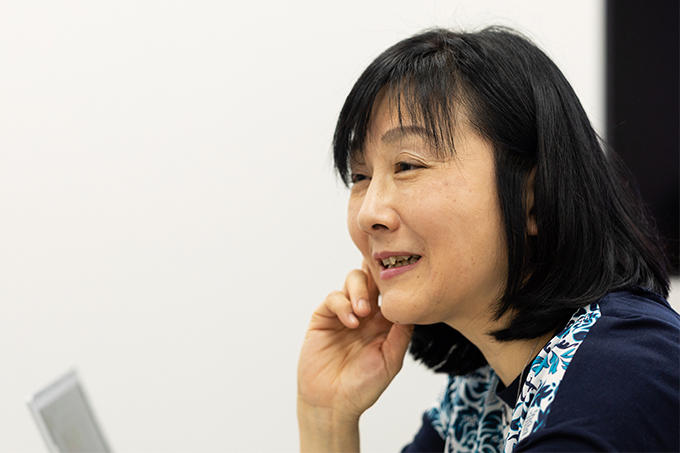
OKI
As a scientist of clouds and rain, I share your curiosity about what happens inside clouds. Clouds are made up of tiny particles of water and ice, which grow as the particles gather and stick together. When the particles get too big and heavy, they start to fall. If they melt along the way, they hit the ground as rain, or as snow or hail if they remain frozen all the way through. But there's a lot we still don't know about clouds, rain, snow and other such weather phenomena, which is why researchers are always working to answer these outstanding questions and better understand this field of science. Being able to observe Earth from space is a necessity for getting this done, so we're working to improve the accuracy of our observations, to gain access to views of the world previously inaccessible to humans.
GSMaP: Global rainfall map in real time, developed by JAXA under the GPM mission
SHINKAI
That is an ongoing mission at JAXA.
OKI
Right. One of our key projects is the Global Precipitation Measurement (GPM). This is a collaborative mission involving not only JAXA and NASA, but also many international institutions. It uses a multi-satellite system to enable observation of the entire global surface on a roughly three-hour cycle. The GPM's core satellite is equipped with the Dual-frequency Precipitation Radar (DPR), a sensor system developed by JAXA. The DPR aboard the GPM satellite shoots radio waves toward Earth, then intercepts the ones that get reflected off of rain and snow. This enables three-dimensional scanning of the internal structure of cloud systems, which was not possible in the past.

SHINKAI
The GPM mission has brought about higher-resolution images of clouds.
OKI
Right. Improved resolution can provide higher-quality three-dimensional images of internal structures, an essential resource in our quest.
3D views that showed intense storms in July 2018, observed
by the DPR (Dual-frequency Precipitation Radar) aboard the GPM's core satellite
SHINKAI
That's impressive. In what way will this higher resolution improve our lives in general?
OKI
Since precipitation is a major source of fresh water, having more accurate measurements of it allows for more appropriate management of global water resources. Other benefits include increased weather forecast accuracy, improved flood warning systems, and better understanding of climate anomalies related to global warming.
Fish in the sky is an image for the mixing of water and wind
OKI
One important component of the setting in Weathering With You is the unusually long rainy weather, which has gradual but significant impacts on the cityscape. As a researcher in the field of precipitation observation, I'm curious about your depiction of rain in this creative context.
SHINKAI
I think rainfall has a psychological effect. The world feels more information-dense when it's wet outside. Picture yourself in Tokyo on a rainy day. You have puddles on the ground reflecting the lights on the streets and the buildings, which makes the whole city look brighter. Or, if you look closely at the raindrops on a window, you'll see the world around you reflected in every drop, making it look like the world has been multiplied infinitely. I'm sure you've also noticed that the sound of rain differs depending on where it falls―on trees, on concrete structures, or in puddles. As such, the sound of rain can give you an idea of the composition of the world around you. I find this fascinating.
OKI
I think it is not easy to present rain effectively in creative work, but your rendering of the weather is very precise and rich, and in impressively high resolution.
SHINKAI
I'd like to talk a little about resolution, since you mentioned the word. Resolution is a key concept I used to create Hina, the lead character of Weathering With You, as a weather maiden. I came up with the idea of depicting her with an extraordinary eye resolution capability, to give her a superhuman, almost divine quality. You see this when she visits the world up in the atmosphere for the first time, and she can see all these tiny fish-like things floating around her. This is a depiction of her special ability to perceive wavelengths outside the human visible light spectrum.
OKI
The fish in the sky is exactly what I wanted to ask you about today.
SHINKAI
The idea behind the fish in the sky is that they're a representation of the mixing of water and wind. You may be an exception, as a precipitation observation expert, but most humans cannot see the vapor in the atmosphere. But Hina, as a weather maiden, can see the flow of vapor through the air. Another part of my intention was to depict the phenomenon of updrafts pushing vapor high into the air.
OKI
Very interesting. My mind is usually busy dealing with cloud droplets, precipitation particles, aerosol particles, and the like, but I was completely comfortable with the flying fish in the film, which looked quite natural. I also enjoyed the white dragon whirling across the sky.
SHINKAI
The dragon is a representation of the westerly jet stream. I imagine it as a giant dragon circling the globe, causing various meteorological phenomena.
OKI
That's logical. The movement of the westerly jet stream can cause many climatic anomalies. The dragon is responsible for the extreme rainy weather in Tokyo.
Complicated and diverse climatic phenomena are
difficult to understand
SHINKAI
Weathering With You was screened in many countries including Japan. While many enjoyed the film as a boy-meets-girl story, it has also received considerable attention as a movie about climate change, especially from overseas.
OKI
I was part of the latter group, as someone who has a primary interest in the climate issue. Viewed in that light, the story gave me confidence in humans' determination to fight against enormous challenges, like the one depicted in the movie.
SHINKAI
I'm glad to hear that. I was hoping the movie would give viewers a more positive outlook on the world, even if only slightly.
OKI
Some time after seeing the movie, I began to become concerned about the storyline climaxing with Hodaka choosing to give up the world in order to save Hina. His decision seems to suggest that we are responsible for our real-life failure to stop the progress of global warming, that it was a choice we made. Did the film receive criticism in light of this?
SHINKAI
It did, and it's natural that a movie would be subject to many different opinions. But I need to emphasize that Weathering With You is fiction, and as such, it's not an attempt to advocate for any political actions. At the same time, I did depict two different views on the climate issue in the movie. You have a shrine priest saying "Abnormal weather is no big thing. You talk about 'firsts on record,' but you're only talking about 100 years," and an old woman saying, "Tokyo has been drowned, but the area was originally under water."
OKI
Another character said, "The world is abnormal from the beginning." That stuck with me.
SHINKAI
The idea that humans aren't capable of changing the climate, and that on the timescale of the planet's history, the events of a mere 100 years don't qualify as an "abnormal climate" state―this theory is often adopted by climate change skeptics. That's the first view, and it's a relatively easy one to accept when you live in Japan, an area already prone to natural disasters. The second view is the theory that the recent phenomena that most people perceive as "abnormal" are the result of human economic activities, and that, in a way, we chose this fate. I think SHIKISAI's mission to observe climate change represents an action driven by the second view. I wanted to incorporate the two views into the fiction, while presenting a very extreme but possible future for our world with regard to the climate issue.
OKI
Climate issues are not simple. Let's take global warming, for example. While ongoing efforts to address this issue are focused on reducing greenhouse gases, particularly carbon dioxide, atmospheric aerosol particles, which play an important role in cloud formation, are said to have a mixed influence on the global warming phenomenon―accelerating and slowing down its progress depending on conditions complicated by a variety of factors. JAXA is working to clarify the effects of aerosol on the atmosphere, particularly its role in the formation and dissolution of clouds and precipitation, as well as global aerosol distribution.

Connection with the universe puts us in touch
with something important
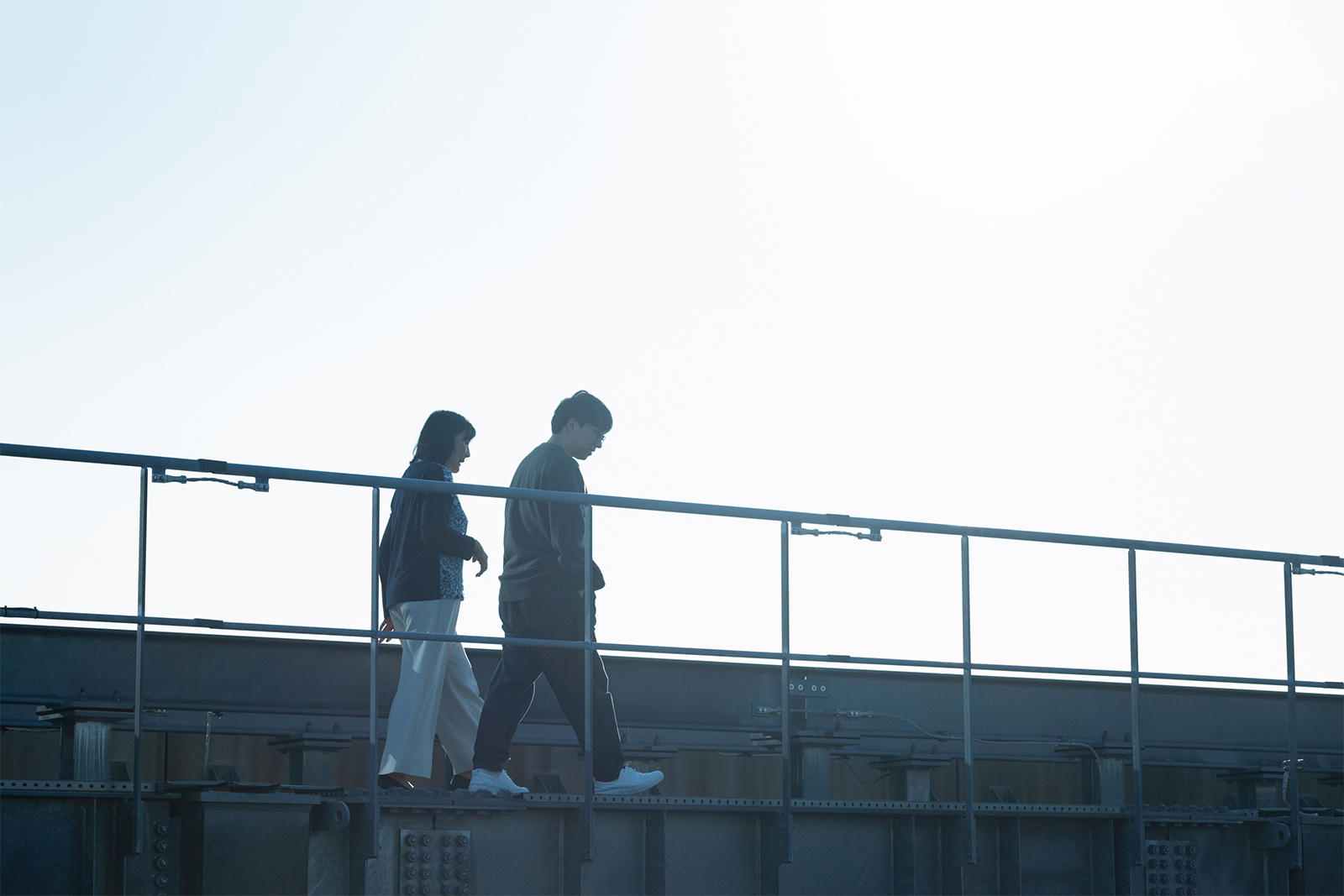
OKI
In your other film, 5 Centimeters per Second, one of the settings used is Tanegashima Island (where the Tanegashima Space Center is located). I was excited to see a poster showing the Earth observation satellite "MIDORI" included in the background of one of the scenes set on the island.
SHINKAI
Thank you. 5 Centimeters per Second was released in 2007, which was more than ten years ago now. My memories of those days are a little foggy, but I did go to the island for location scouting for the movie. While exploring, I noticed a number of things indicating the community's close connected with JAXA, such as NASDA (presently JAXA) ad posters on the wall of a convenience store, and photos of a H-IIA launch vehicle liftoff decorating the hallways of a local high school. I wanted to incorporate this unique aspect of the island into my depiction of the setting.
OKI
You see a truck carrying a launch vehicle pass by the boy and the girl when they're walking home from school, and a rocket lifting off in the background of a climactic scene.
SHINKAI
I wanted to tell the story of a girl suffering a poignant sense of unrequited love. This girl has secretly been in love with her classmate, and decides to confess her feelings to him. But just as she tries to tell him she loves him, she realizes he is looking for something far beyond what she can offer, and decides not to say anything. They're watching the rocket launch from a distance in this scene.
OKI
Your movies provide viewers with the awesome experience of connecting with the broader universe through personal emotions such as love. And you manage to do it so seamlessly. That's really fascinating.
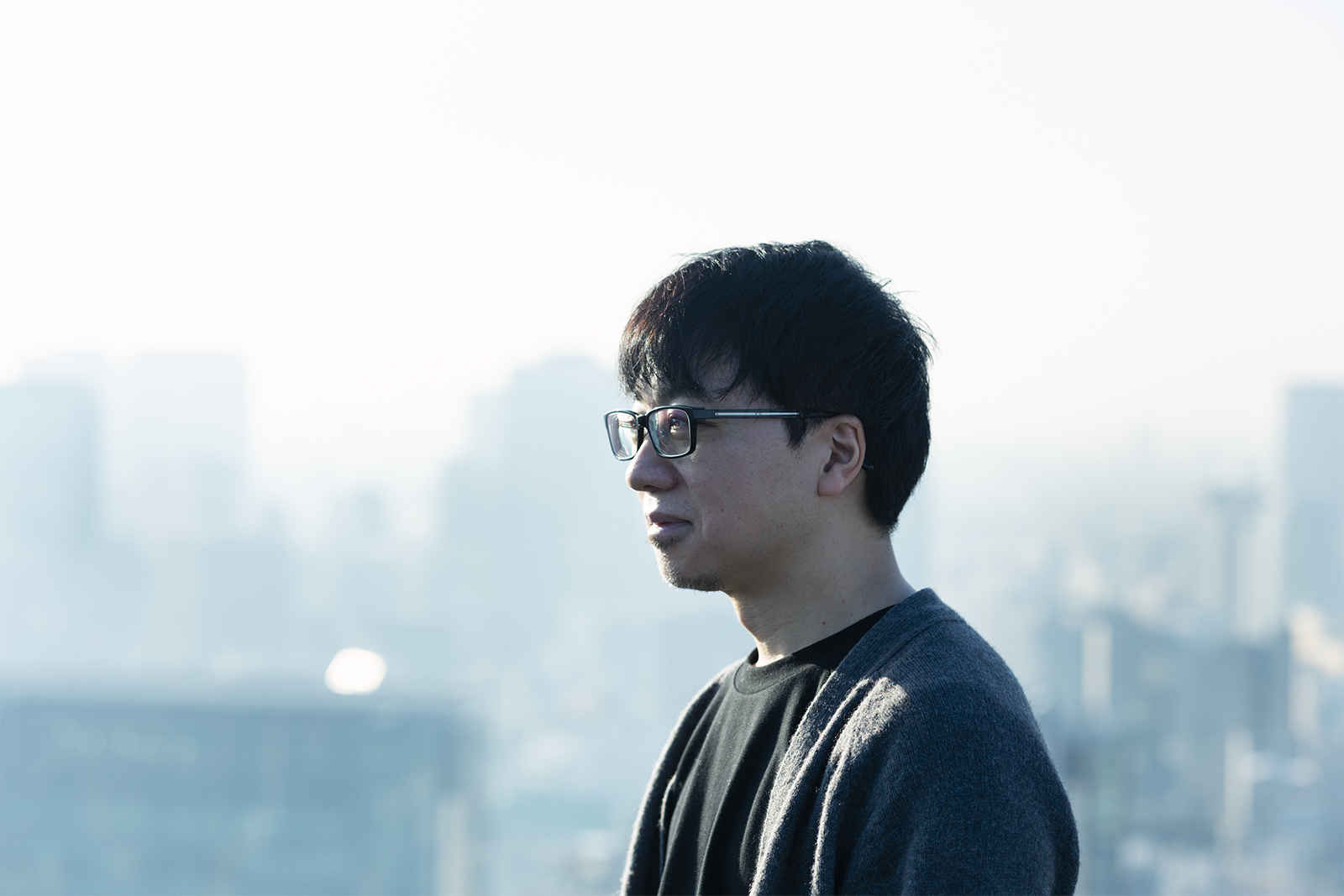
SHINKAI
I think people by nature want to experience a sense of connection between the micro world of the personal and the macro world of the universe. I grew up in Nagano Prefecture, near the district at the foot of Mt. Yatsugatake where Nobeyama Radio Observatory is located. The region provides beautiful starry sky views, and I liked watching the sunset and stars from the childhood. In my later teens, the typical anxieties of youth made me feel completely detached from that vast, beautiful universe. But occasionally, gazing up at the twinkling stars, I was reminded that I was still a part of this world. That relieved some of that pain, even if only momentarily, and I came close to tears at those moments. Presenting those precious experiences―that blink-of-an-eye-moment sense of connection with something meaningful that transcends time and space―is my strongest passion and drive for filmmaking.
OKI
A feeling of being part of this world―I think I experience that through my observation of Earth. To deliver a more solid sense of connection with the world and to help improve life for many people, I will continue with my research into more accurate observation of unexplained meteorological phenomena.
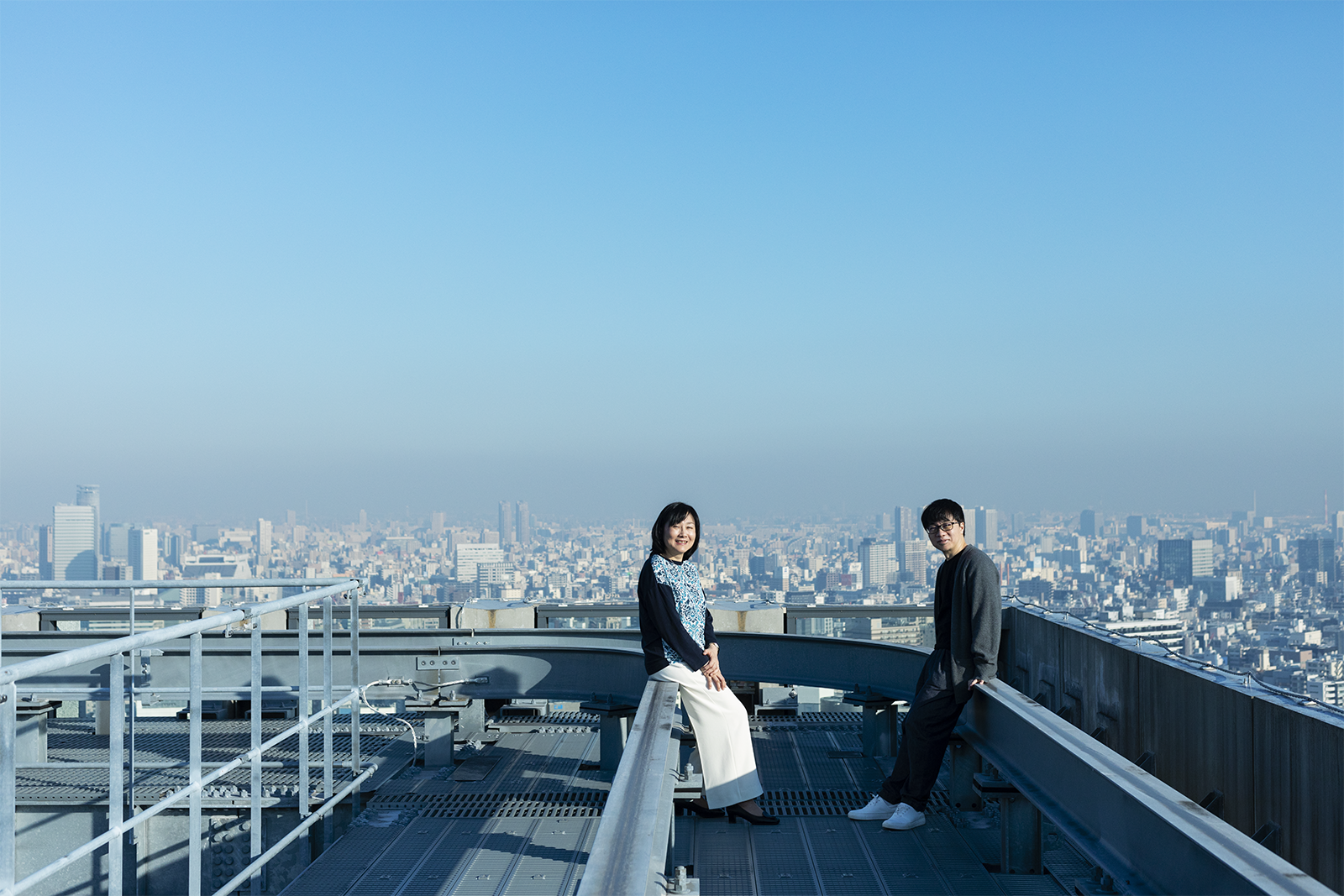
Profile
OKI Riko
Born in Tokyo, she is a meteorologist and climatologist. After completing her doctoral dissertation on the theme of precipitation observation, she joined the then-National Space Development Agency of Japan (NASDA), later renamed JAXA. She has since built her expertise career in the field of Earth observation research. Also busy at home childrearing, in her free time she enjoys playing and listening to the piano.
SHINKAI Makoto (Animation film director)
Born in Nagano Prefecture, he made his animated film debut in 2002, releasing Voices of a Distant Star, a self-produced short film. This was followed by The Place Promised in Our Early Days, 5 Centimeters per Second, Children Who Chase Lost Voices, The Garden of Words, and Your Name. His latest film title is Weathering With You, released in 2019. Set in a Tokyo affected by abnormal weather, the story follows Hodaka, a runaway boy, and Hina, a girl with supernatural powers, who fight together against a cruel destiny to choose their life for themselves. It has been screened in a total of 140 countries and regions and topped the 2019 domestic box office ranking. (Available in Blu-ray and DVD format starting May 27, 2020)
All the images are copyrighted ©JAXA unless otherwise noticed.
- Home>
- Global Activity>
- Public Relations>
- JAXA’s>
- JAXA's No.80>
- Special Talk: Introduction to Meteorology